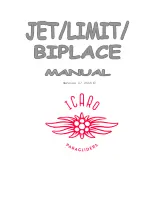
hemisphere is good. The view to the left and right rear is partially obscured by the wings,
therefore use caution when maneuvering into these directions
3. The recommended thermalling speed is 85-95 km/h (46-51 kt), depending on the flight
weight of the aircraft. The aircraft keeps the required attitude and speed with minimal
control intervention. The roll rate is approximately 3 seconds for a 45 degree to 45
degree roll.
4.
When flying close to the upper speed limit (yellow arc on the airspeed indicator), i. e. 150
- 205 km/h (81,0-110,7 kt), use ony a maximum of 1/3 deflection of the control elements.
Deflect smoothly and carefully to avoid excessive loading of the airframe and control
surfaces. Dive brakes must be extended slowly and smoothly, speed should be reduced
to 150 km/h (81 kt) before retracting them.
4.8.4 EXTENDING AND RESTARTING OF THE ENGINE IN FLIGHT
Bring the aircraft into level flight mode, reduce flight speed to 90-100 km/h (49-54 kt) and
carry out the following steps:
1. insert the key into the switch box, turn right to position 1. Green pilot lamp must be alight
2. push the engine extension push button for approx 1 second. The relevant pilot lamp must
flash. The engine is being extended
3. full extension is signalled by extinguishing of the pilot lamp
4. open the fuel valve
5. ignition switch on. Turn the starter key further right and start the engine. In case the
engine has not been run for an extended period of time or is cool, use the fuel primer
6. turn the key back to position 0
WARNING
: Take into account that the time necessary for the extension of the engine and its
starting takes approximately one minute. Recognize also, that while extending the engine,
the sink rate of the aircraft will increase geometrically with the degree of the erection until the
engine is running. To fully understand the effect of the engine extention process while in
flight, one should practice as follows:
•
on the first attempt, one should climb to 4000 ft AGL or above and then shut down the
engine. With a watch, measure the time required to descend 500 ft. This will demonstrate
the sink rate when a “dead” engine is sitting back there fully erected
•
retract the engine so that thermal climbing is possible. Climb back up to over 4000 ft AGL
and mark altitude loss while fully erecting the engine (as in paragraph 3.10.3 above) and
getting it started.
Only then can one have a relatively reliable understanding of how much altitude will be lost in
the erecting process and how much more will be lost if the engine fails to start the first time.
That knowledge then will help you determine at what altitude the engine can be safely
extended and started. If an occasion arises later to attempt a restart and the altitude above
the ground is below that predetermined figure, one must abandon a restart and complete an
emergency landing.
WARNING:
Extending of the engine and its starting to be always done only in stable straight
flight. Remember, that the engine with a stopped propeller causes a significant increase in
drag and deterioration of the flight characteristics
WARNING
: Remember, that your engine and accessories is only an auxiliary power unit.
Always fly in such a way as to be able to land on a suitable area in the terrain in case engine
TST-14 M – Aircraft Manual
rev.0 issued 2006-11-29 – page 25 of 40










































